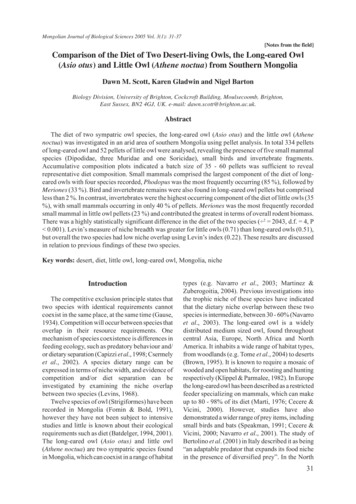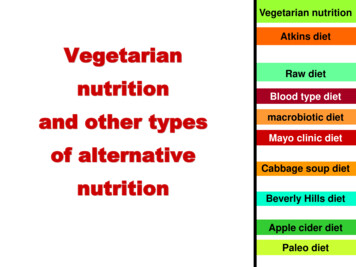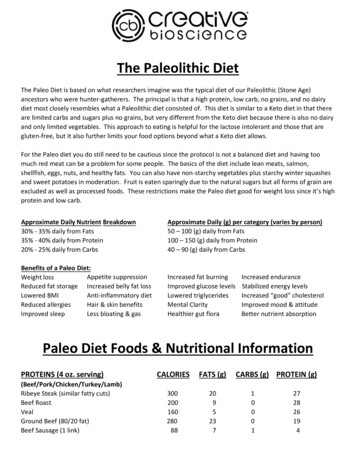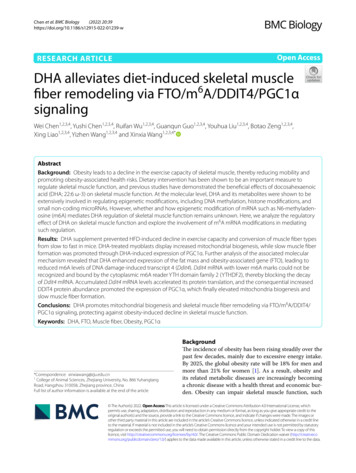
Transcription
Mongolian Journal of Biological Sciences 2005 Vol. 3(1): 31-37[Notes from the field]Comparison of the Diet of Two Desert-living Owls, the Long-eared Owl(Asio otus) and Little Owl (Athene noctua) from Southern MongoliaDawn M. Scott, Karen Gladwin and Nigel BartonBiology Division, University of Brighton, Cockcroft Building, Moulsecoomb, Brighton,East Sussex, BN2 4GJ, UK. e-mail: dawn.scott@brighton.ac.uk.AbstractThe diet of two sympatric owl species, the long-eared owl (Asio otus) and the little owl (Athenenoctua) was investigated in an arid area of southern Mongolia using pellet analysis. In total 334 pelletsof long-eared owl and 52 pellets of little owl were analysed, revealing the presence of five small mammalspecies (Dipodidae, three Muridae and one Soricidae), small birds and invertebrate fragments.Accumulative composition plots indicated a batch size of 35 - 60 pellets was sufficient to revealrepresentative diet composition. Small mammals comprised the largest component of the diet of longeared owls with four species recorded, Phodopus was the most frequently occurring (85 %), followed byMeriones (33 %). Bird and invertebrate remains were also found in long-eared owl pellets but comprisedless than 2 %. In contrast, invertebrates were the highest occurring component of the diet of little owls (35%), with small mammals occurring in only 40 % of pellets. Meriones was the most frequently recordedsmall mammal in little owl pellets (23 %) and contributed the greatest in terms of overall rodent biomass.There was a highly statistically significant difference in the diet of the two species ( 2 2043, d.f. 4, P 0.001). Levin’s measure of niche breadth was greater for little owls (0.71) than long-eared owls (0.51),but overall the two species had low niche overlap using Levin’s index (0.22). These results are discussedin relation to previous findings of these two species.Key words: desert, diet, little owl, long-eared owl, Mongolia, nicheIntroductionThe competitive exclusion principle states thattwo species with identical requirements cannotcoexist in the same place, at the same time (Gause,1934). Competition will occur between species thatoverlap in their resource requirements. Onemechanism of species coexistence is differences infeeding ecology, such as predatory behaviour and/or dietary separation (Capizzi et al., 1998; Csermelyet al., 2002). A species dietary range can beexpressed in terms of niche width, and evidence ofcompetition and/or diet separation can beinvestigated by examining the niche overlapbetween two species (Levins, 1968).Twelve species of owl (Strigiformes) have beenrecorded in Mongolia (Fomin & Bold, 1991),however they have not been subject to intensivestudies and little is known about their ecologicalrequirements such as diet (Batdelger, 1994, 2001).The long-eared owl (Asio otus) and little owl(Athene noctua) are two sympatric species foundin Mongolia, which can coexist in a range of habitattypes (e.g. Navarro et al., 2003; Martinez &Zuberogoitia, 2004). Previous investigations intothe trophic niche of these species have indicatedthat the dietary niche overlap between these twospecies is intermediate, between 30 - 60% (Navarroet al., 2003). The long-eared owl is a widelydistributed medium sized owl, found throughoutcentral Asia, Europe, North Africa and NorthAmerica. It inhabits a wide range of habitat types,from woodlands (e.g. Tome et al., 2004) to deserts(Brown, 1995). It is known to require a mosaic ofwooded and open habitats, for roosting and huntingrespectively (Klippel & Parmalee, 1982). In Europethe long-eared owl has been described as a restrictedfeeder specializing on mammals, which can makeup to 80 - 98% of its diet (Marti, 1976; Cecere &Vicini, 2000). However, studies have alsodemonstrated a wider range of prey items, includingsmall birds and bats (Speakman, 1991; Cecere &Vicini, 2000; Navarro et al., 2001). The study ofBertolino et al. (2001) in Italy described it as being“an adaptable predator that expands its food nichein the presence of diversified prey”. In the North31
D. M. Scott et al.American deserts the long-eared owl was describedas an opportunistic forager, feeding on a wide rangeof mammal species including rabbits (Sylvilagu sp.)and hares (Lepus sp.) (Craig et al., 1984).The little owl, the smaller of the two species,also inhabits a wide range of environments fromopen habitats, such as steppe (Navarro et al., 2003),to rocky areas and desert (Obuch & Kristin, 2004).However, in contrast to long-eared owls this speciesstrongly avoids wooded areas and prefers opengrassland for foraging (Kitowski & Kisiel, 2003).It has been shown to be largely insectivorous, withover 50% of the diet being comprised ofinvertebrates in northern Italy (Gotta & Pigozzi,1997). However in terms of biomass, the diet isdominated by small mammals (Capizzi & Luiselli,1996; Goutner & Alivizatos, 2003) and it will alsotake small birds (Obuch & Kristin, 2004). Severalauthors have described its diet as opportunistic,reflecting temporal variations in prey availability(Goutner & Alivizatos, 2003).The aims of this study were to i) assess thesummer diet of two desert-living owl species, ii)investigate dietary width and overlap between thetwo species to assess competitive pressure andcoexistence mechanisms and iii) compare thesefindings with previous studies to investigate theimpacts of locality on the diet composition.Materials and MethodsThe study was conducted between June and July2004 in the arid Little Gobi Strictly Protected Area‘A’, in southern Mongolia. Climate in this area iscontinental with winter temperatures dropping to 10ºC, and summer temperatures up to 40ºC. Annualrainfall is less than 50 mm, and mainly falls betweenJuly and August. Habitat types in the area includerocky outcrops, sparsely vegetated gravel plainsand meandering wadis dominated by Tamarix sp.and Haloxylon ammodendri.Four batches of pellets were collected fromroosting sites of each species within a 3 km zonesurrounding N 42º 11' 30" and E 105º 20' 40". Fromthe four individual long-eared owl roosts, 124, 100,71 and 39 pellets were collected, and from the littleowl roosts, batches of 8, 9, 13 and 22 pellets werecollected. Pellets were analysed separately, usingonly complete pellets, with prey species beingidentified using the skull and/or dentaries. The totalnumber of individual prey items in the pellet wasdetermined using the total number of dentaries or32skulls, whichever was greater (Yalden & Morris,1990). Pellets with skulls present that could not beidentified due to extensive damage or partialrecovery were excluded from the analysis. Preyitems were categorised into small mammals, birdsor invertebrates. Species were identified to genuswhere possible by comparing skulls to a museumreference collection.To confirm small mammal species present inthe area, opportunistic live trapping was undertakenusing Sherman traps (23cm x 9cm x 7.5cm). Forthe bipedal Dipodidae, hand capture with butterflynets was undertaken whilst spotlighting at night(Scott & Dunstone, 2000). These surveys wereundertaken in representative habitats in parallelwith the pellet collection. To determine the numberof pellets required from a single roost site to assessthe representative diet composition, accumulativeaverage composition of pellets was plotted againstincreasing pellet sample size for each species. Thepoint at which the graph stabilises and levels out isconsidered an appropriate sample size. Theimportance of each rodent species in the diet, interms of biomass, was calculated using averagebody weight determined from live trapping;Meriones 60g, Dipus 80g, Cricetulus 45gand Phodopus 15g. Species biomass wasmultiplied by the number of individuals foundwithin each pellet. Overall biomass contributionper rodent species was then summed for all pelletsand expressed as a percentage. Niche wasdetermined by calculating Levin’s measures ofniche breadth for each species and Levin’s indexof niche overlap between the two species based onpercentage frequency occurrence data (Waite,2000). A chi-squared test was applied to test thedifference in diet composition between the two owlspecies.ResultsAll roost sites for long-eared owls were in treesclose to, or on the edge of, a riverbed. Roost sitesappeared to be extensively used, with numerouspellets (over 400 pellets were found at one roostingsite). Little owl roosting sites were more difficultto locate, usually amongst rocky outcrops withrelatively fewer pellets found per site. A total of334 pellets were analysed for long-eared owls and52 pellets for little owls. Prey items found withinthe diet were Dipodidae (Dipus sagitta), threespecies of Muridae (Cricetulus migratorius,
D. M. Scott et al.Figure 3. The percentage frequency of occurrence of prey items in the diet of long-eared owls and little owls ina desert region of Southern Mongolia.Figure 4. Relative importance of each rodent species in the diet of long-eared owls and little owls, expressed interms of percentage of total rodent biomass.niche breadth than long-eared owls (0.70 asopposed to 0.51), but overall the two species had alow level of niche overlap using Levin’s index(0.22).Discussion and ConclusionOur study showed little owls to have a greaterniche breadth than long-eared owls. This differencewas predominately due to the specialisation of longeared owls on a few species of small mammal, incontrast to the little owl which used a wider rangeof items more evenly. Long-eared owls are knownto demonstrate selectivity of higher-ranking smallmammal prey (Craig et al., 1985; Tome, 2003).Previous studies have also reported a wide dietaryniche width for little owls and high prey diversitydue to its common utilisation of invertebrate preyitems as well as small mammals (Navarro et al.,2003; Goutner & Alivizatos, 2003). Solifugae havealso been found in the diet of little owls inhabitingdesert regions (Obuch & Kristin, 2004) however,34contrary to other desert studies no Lacertidae wererecovered from pellets in our study. We did findinvertebrates in the long-eared owl diet but at verylow occurrence. Little owls have been reported insome areas to be largely insectivorous (Obuch &Kristin, 2004), with over 50 % of their diet beingcomprised of invertebrates in northern Italy (Gotta& Pigozzi, 1997). In our study invertebratesoccurred in 35% of pellets. However in terms ofbiomass, the diet is dominant by small mammals(Capizzi & Luiselli, 1996; Goutner & Alivizatos,2003). In our study no biomass data were derivedfor birds, invertebrates or Soricidae, therefore theimportance of these prey items in the diet may beunder or over estimated based on frequencyoccurrence data alone. When looking at our relativebiomass of the rodent species, it is evident thatMeriones is an important prey item for both littleowls and long-eared owls. However, Dipus wasfound more frequently in the diet of little owls thanlong-eared owls and the inverse was true forPhodopus. The two species evidently utilise the
Diet of long-eared owl and little owl in southern Mongoliaavailable rodent prey base to different extents. Littleowls have previously been reported to takeMeriones, Cricetulus and Dipodidae in middleeastern and Asian deserts (Obuch & Kristin, 2004).Marks & Yensen’s study in 1980 found that mostof the prey of long-eared owls weighed between10 and 60 g and that prey over 100 g was lessimportant in their diet. The mean weight of smallmammals ingested in this study was not similar toprevious findings. Due to their smaller body mass,little owls were expected to take smaller prey itemsthan long-eared owls. In northern Italy, Gotta &Pigozzi, (1997) found the average prey weight forlittle owls to be 22.3 g. In our study the averageprey weight was 56 g, compared to 25 g for longeared owls. These data may reflect the relativeabundance of prey in different habitat types; forexample, low levels of Cricetulus recorded in thediet may reflect this species relative abundance and/or its susceptibility to predation. However, thesefindings need further investigation.From this and other studies it appears that habitatpreferences, feeding behaviour and dietaryseparation are potential mechanisms forcoexistence of these two sympatric species. Habitatselection of roosting sites was evident, with longeared owls preferring wooded areas whereas littleowls preferred rocky outcrops, similar to thefindings of Martinez & Zuberorgoitia (2004).Dietary partitioning was evident in this study fromlow niche overlap (0.22), which has also beenshown in phylogenetically related owl species(Capizzi & Luiselli, 1996). Sympatric owls alsodisplay species-specific specialisations in feedingand hunting behaviour techniques (Csermely et al.,2002).Both owl species have been reported asopportunistic or adaptable predators (Bertolino etal., 2001; Goutner & Alivizatos, 2003), withseasonal differences occurring in their diet inrelation to physiological requirements and preyavailability (Alivizatos & Goutner, 1999; Tome,1997, 2003). Long-eared owls have been shown totake more birds during the breeding season, whichis reflected in their seasonal niche breadth(Bertolino et al., 2001). Additionally, it is evidentfrom the range of studies that diet also variesspatially. The distribution and diet of little owlscan be affected by the surrounding landscapemosaic (Ferrus et al., 2002). Our study was onlyundertaken in one season, in one year and over arestricted area, therefore it only provides a snapshotof the diet of the two owl species studied. Furtherseasonal samples over a wider area would be neededto provide a more accurate picture of dietarycomposition and ecological requirements.Our preliminary analysis suggested that thesample size was sufficient to give an indication ofdiet composition. Limited numbers of roosting sitesand pellets from the little owl did not allow forinvestigations into individual differences in diet.It is suggested from the number of individualowls sighted within the study area and the numberof pellets recovered from roost sites that anindividual little owl may have exclusive use of aroost site, whereas the long-eared owl roosts maybe used communally (Holt, 1997). As no referencecollection of skulls was collected from the site, skullremains were identified by comparison withmuseum specimens from other areas. No museumsample was available for Phodopus; therefore thiswas identified using available literature (Allen,1940). All species identification should beconfirmed by comparisons with local specimens.AcknowledgmentsWe would like to thank all the students and stafffrom the National University of Mongolia that tookpart in the pellet analysis during the Steppe ForwardProgramme field trip 2004 to the Little Gobi StrictlyProtected Area ‘A’. We would also like to thankthe National Park Authorities for permission to visitthe site and the Harrison Institute, UK for aid withskull identification. The project was funded by theDarwin Initiative Steppe Forward Programme incollaboration with the Zoological Society ofLondon and supported by the Mongolian Ministryof Nature and Environment.ReferencesAlivizatos, H. & Goutner, V. 1999. Winter diet ofthe barn owl (Tyto alba) and long-eared owl(Asio otus) in northeastern Greece: Acomparison. J. Raptor Res. 33: 160-163.Allen, G.M. 1940. The mammals of China andMongolia. Part 2. Publications of AmericanMuseum of Natural History. Central AsiaticExpeditions.Batdelger, D. 1994. Conservation of Raptors inMongolia: Current status and problems. J.Omithol. 135, Sonderheft: 214Batdelger, D. 2001. Current Status and35
D. M. Scott et al.Conservation Problems of Birds of Prey inMongolia. Oral presentation abstract, 4 thEurasian Congress on Raptors, Seville.Bertolino, S., Ghiberti, E. & Perrone, A. 2001.Feeding ecology of the long-eared owl (Asiootus) in northern Italy: is it a dietary specialist?Canadian J. Zoology, 79: 2192-2198.Brown N.L. 1995. Notes on the winter roost anddiet of long-eared owls in the Sonoran Desert.J. Raptor Res. 29 (4): 277-279.Capizzi, D. & Luiselli, L. 1996. Feedingrelationships and competitive interactionsbetween phylogenetically unrelated predators(owls and snakes). Acta Oecologica, 17: 265284.Capizzi, D., Caroli, L. & Varuzza, P. 1998. Feedinghabits of sympatric long-eared owl Asio otus,tawny owl Strix aluco and barn owl Tyto albain Mediterranean coastal woodland. ActaOrnith. 33: 85-92.Cecere, F. & Vicini, G. 2000. Micromammals inthe diet of the long-eared owl (Asio otus) at theW.W.F.’s Oasi San Giuliano, (Matera, SouthItaly). Hystrix 11 (2): 47-53.Craig, T.H., Craig, E.H. & Powers, L.R. 1984. Foodhabits of long-eared owls (Asio otus) at acommunal roost site during the nesting season.Auk 102: 193-195.Csermely, D., Casagrande, S. & Sponza, S. 2002.Adaptive details in the comparison of predatorybehaviour of four owl species. Italian J. Zool.69: 239-243Ferrus, L., Genot, J.C., Topin, F., Baudry, J. &Giraudoux, P. 2002. Distribution of littleowl (Athene noctua Scop.) at various scales oflandscape analysis. Revue D Ecologie-la Terreet la Vie 57: 39-51.Fomin, V.E. & Bold, A. 1991. Catalogue of thebirds of the Mongolian People’s Republic.Nauka Press, Moscow. pp. 126.Gause, G.F. 1934. The Struggle for Existence.Williams and Wilkins, Baltimore.Gotta, A. & Pigozzi, G. 1997. Trophic niche of thebarn owl and little owl in a rice field habitat innorthern Italy. Italian J. Zool. 64: 55-59.Goutner, V. & Alivizatos, H. 2003. Diet of the barnowl (Tyto alba) and little owl (Athene noctua)in wetlands of northeastern Greece. Belgian J.of Zool. 133: 15-22.Holt, D.W. 1997. The long-eared owl (Asio otus)and forest management: A review of theliterature. J. Raptor Res. 31: 175-186.Kitowski, I. & Kisiel, E. 2003. Distribution of little36owl Athene noctua and barn owl Tyto alba inthe Zamoœæ Region (SE Poland) in the light ofatlas studies. Ornis Hungarica 12-13:1-2.Klippel, W.E. & Parmalee, P.W. (1982). Prey of awintering long-eared owl in Nashville Basin,Tennessee. J. Field Ornith. 53 (4): 418-420.Levins. R. 1968. Evolution in changingenvironments. Princeton University Press,Princeton, N.J.Marks, J.S. & Yensen, E. 1980. Nest sites and foodhabits of long-eared owls in southwesternIdaho. Murrelet 61: 86-91.Marti, C.D. 1976. Review of prey selection by thelong-earned owl. Condor 78 (3): 331336.Martinez, J.A. & Zuberogoitia, I. 2004. Habitatpreferences for long-eared owls Asio otus andlittle owls Athene noctua in semi-aridenvironments at three spatial scales. Bird Study51 (2): 163-169.Navarro, J., Sanchez-Zapata, J.A., Carrete, M.,Botella, F., Gavrilov, A., Sklyarenko, S.,Donazar, J.A., Ceballos, O. & Hiraldo, F. 2003.Diet of three sympatric owls in steppe habitatsof eastern Kazakhstan. J. Raptor Res. 37 (3):256-258.Obuch, J. & Kristin, A. 2004. Prey composition ofthe little owl Athene noctua in an arid zone(Egypt, Syria, Iran). Fol. Zool. 53, 65-79.Scott, D.M. & Dunstone N. 2000. Environmentaldeterminants of desert-living rodent communitystructure in the north-east Badia region ofJordan. J. Zool. London 251:481-494.Speakman, J.R. 1991. The impact of predation bybirds on bat populations in the British Isles.Mammal Review 21(3): 123-142.Tome, D. 1997. Diet composition of the long-earedowl (Asio otus) in central Slovenia - seasonalvariation in prey use. J. Raptor Res. 28: 253258.Tome, D. 2003. Functional response of the longeared owl (Asio otus) to changing prey numbers:a 20 year study. Ornis Fennica. 80: 63-70.Tome, R., Bloise, C. & Korpimaki, E. 2004. Nestsite selection and nesting success of little owls(Athene noctua) in Mediterranean woodlandand open habitats. J. Raptor Res. 38: 35-46.Waite, S. 2000. Statistical Ecology in Practice: Aguide to the analysis of environmental andecological field data. Prentice Hall. pp. 414.Yalden D.W. & Morris P.A. 1990. The Analysis ofOwl Pellets. The Mammal Society, UK.
Diet of long-eared owl and little owl in southern MongoliaÕóðààíãóéÌîíãîë îðíû ºìíºä á¿ñ íóòàãò òàðõñàíÿâëèã óóëü (Asio otus), õîòíû á¿ãýýõýé (Athenenoctua) çýðýã õî ð ñèìïàòðèê ç¿éëèéí øàðøóâóóíû èäýø òýæýýëèéí ñóäàëãààããóëãèäàñíû çàäëàí øèíæèëãýýíèé àðãààðñóäëàâ. Íèéò ÿâëèã óóëüíû 334 ãóëãèäàñ,õîòíû á¿ãýýõýéíèé 52 ãóëãèäàñ öóãëóóëàíçàäëàí øèíæèëãýý õèéæ 5 ç¿éëèéí æèæèãõºõòºí àìüòàí (1 ç¿éë Dipodidae, 3 ç¿éëMuridae, 1 ç¿éë Soricidae îâãèéí) áîëîíæèæèã øóâóóä, ñýýð íóðóóã¿é .Èäýøòýæýýëõóðèìòëàãäñàí ãàçàð íóòàãò 30-60 ãóëãèäàñûãñóäëàõàä ò¿¿íä àãóóëàãäàõ èäýø òýæýýëèéíá¿ðýëäýõ¿¿íèéã òîäîðõîéëîõîä õàíãàëòòàéáîëîõ íü òîãòîîãäîâ. ßâëèã óóëüíû èäýøòýæýýëèéã á¿ðýëäýõ¿¿íèé èõýíõ õýñãèéã 4ç¿éëèéí æèæèã õºõòºí àìüòàí ýçýëæ áóé íüòîãòîîãäñîí áºãººä, Podopus òºðëèéíàìüòíû ¿ëäýãäýë õàìãèéí èõ òîõèîëäîöòîé(85%), ò¿¿íèé äàðàà Meriones òºðëèéíàìüòíû ¿ëäýãäýë (33 %) ìºí ýëáýã òîõèîëäîæáàéâ. ßâëèã óóëüíû ãóëãèäñàíä ñýýðíóðóóã¿éòýí áà øóâóóíû ¿ëäýãäýë 2%-ààñáàãà õýìæýýãýýð îëäîæ áàéâ. Õàðèí ¿¿íèéýñðýãýýð õîòíû á¿ãýýõýéíèé ãóëãèäñàíä ñýýðíóðóóã¿é àìüòäûí ¿ëäýãäýë õàìãèéí èõõýìæýýãýýð (35%) òîõèîëäîæ, æèæèã õºõòºíàìüòäûí ¿ëäýãäýë íèéò ãóëãèäàñíû äºíãºæ40%-ä íü èëýð áàéëàà. Õîòíû á¿ãýýõýéíèéãóëãèäñàíä Meriones òºðëèéí è ¿¿ëíèé¿ëäýãäýë õàìãèéí èõ òîõèîëäîöòîé (23%)áàéñàí áºãººä ãóëãèäàñíààñ èëýðñýí íèéòìýðýã �¿ðä¿¿ëæ áàéâ. Ýíýõ¿¿ 2 ç¿éë øºíèéèäýâõòýé ìàõ èí øóâóóíû èäýø òýæýýëèéíá¿ðýëäýõ¿¿íä ñòàòèñòèê øèíæèëãýý õèéõýäèõýýõýí ÿëãààòàé áîëîõ íü èëýðëýý ( 2 2043,d.f. 4, P 0.001). Levin-èé õýìæ¿¿ðýýð àâ ¿çâýë õîòíû á¿ãýýõýéíèé ýêîëîãèéí íèøáóþó àìüäðàõ îð èí, àìüäðàëûí ¿éëàæèëëàãàà, èäýø òýæýýëèéí á¿ðýëäýõ¿¿íèéõàìðàõ õ¿ðýý ã.ì. ¿ç¿¿ëýëò (0.71) íü ÿâëèãóóëüíû ýêîëîãèéí íèø (0.51) áóþó äýýðäóðüäñàí ¿ç¿¿ëýëòýýñ èë¿¿ ºðãºí õ¿ðýýòýéáîëîõ íü èëýðñýí þì. Ãýâ Levin-èéèíäåêñýýð õàðüöóóëæ ¿çâýë ýíýõ¿¿ 2 ç¿éëóóëüíû ýêîëîãèéí íèøèéí äàâõöàëõàðüöàíãóé áàãà (0.22) áîëîõ íü òîãòîîãäîâ.Ýíýõ¿¿ ñóäàëãààíû ¿ð ä¿íã äýýð äóðüäñàí 2ç¿éë óóëüíû ºìíºõ ñóäàëãààíû ìýäýýáàðèìòòàé õîëáîí òàéëáàðëàñàí áîëíî.Received: 18 May 2005Accepted: 28 June 200537
0.001). Levin's measure of niche breadth was greater for little owls (0.71) than long-eared owls (0.51), but overall the two species had low niche overlap using Levin's index (0.22). These results are discussed in relation to previous findings of these two species. Key words: desert, diet, little owl, long-eared owl, Mongolia, niche .











